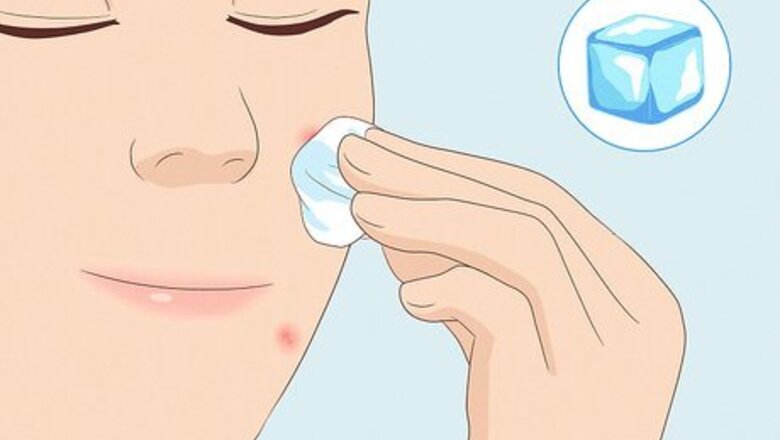
views
X
Trustworthy Source
American Academy of Dermatology
Professional organization made of over 20,000 certified dermatologists
Go to source
Although they can be really stressful when they show up, pimples are a common skin condition. If you’re struggling with acne, don’t panic: we’re here to help with this guide on how to get rid of a hard pimple.
Getting Rid of Hard Pimples with Over-the-Counter Treatments
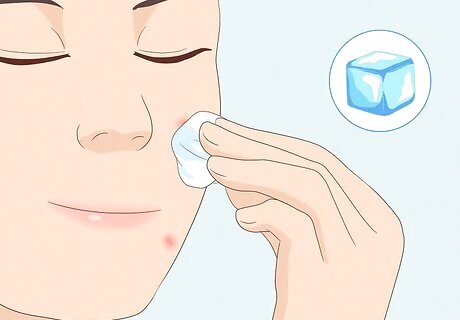
Use an ice pack to reduce pain and swelling. When you notice a pimple forming, wrap an ice cube in a paper towel apply it to your skin for 5-10 minutes. Take a break for 10 minutes, then repeat this process twice. If your pimple has become a whitehead, you can also apply a warm compress. Soak a washcloth in hot water, then apply it to your pimple for 10-15 minutes. Repeat this process 3-4 times a day until the pimple releases its pus and heals.
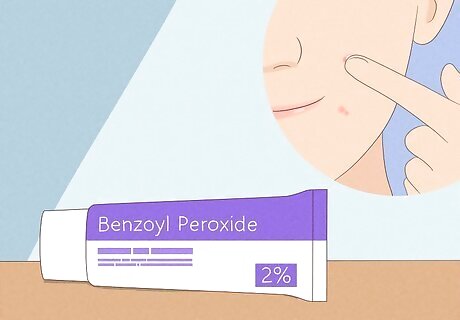
Apply benzoyl peroxide to your pimple. Most drugstores will offer products with 2% benzoyl peroxide over-the-counter. Use your fingers to apply a very thin layer onto your pimple, and let it absorb. Use benzoyl peroxide on your skin 1-2 times a day. Benzoyl peroxide works by killing the bacteria that cause acne. As a peroxide product, benzoyl peroxide can bleach fabrics. Keep it away from your clothing, and consider sleeping on white sheets or towels if you’re applying it before bed.
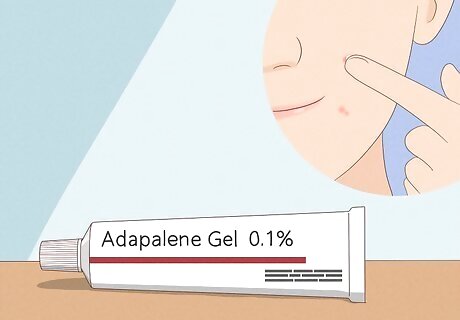
Spread adapalene gel on your acne. Adapalene gel is a retinol with excellent clinical results that has been made available over the counter. Apply a thin layer of 0.1% adapalene gel onto your pimple once a day. The gel will clear out your pores and reduce inflammation from acne.
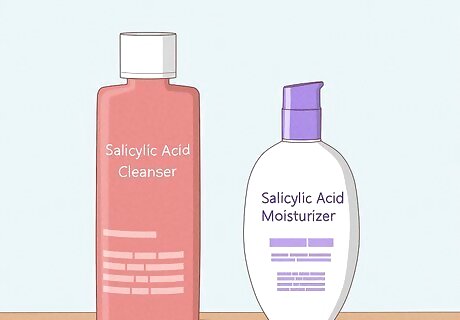
Use a product with salicylic acid. Salicylic acid is another proven method to smooth out the texture and appearance of your skin. Drugstores offer salicylic acid products in concentrations of 0.05% to 5%. Follow the instructions on the product label to see how often you should apply the treatment. Higher concentrations of salicylic acid products are available, but only by prescription. Higher over-the-counter concentrations are likely to produce more noticeable effects, but can also cause your skin to peel.
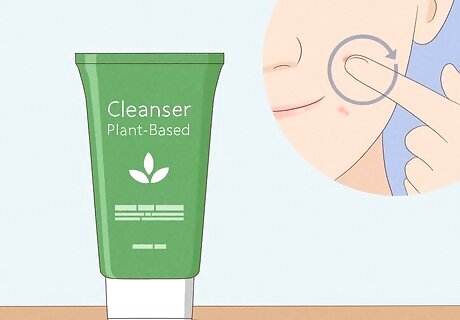
Wash your face and other affected areas twice a day. Use your fingertips to apply a gentle, plant-based cleanser, and gently rub it on your face in a circular motion. Try not to scrub your face or harshly exfoliate it. This can cause permanent scarring and your skin will take longer to heal. Avoid washing your face much more than twice a day, since this can dry out your skin. Wash your face once in the morning and once before bed, and again if you’ve been sweating a lot. Look for a cleanser labeled as “non-comedogenic.” This means that the product does not promote the formation of acne, blackheads, whiteheads, or pimples. Harsh soap or cleansers can dry out your skin and make it more prone to acne. Opt for gentle cleansers, and switch to another product if you get rashes or other negative reactions. Nodules and cysts do not happen because your face or other parts of your body aren’t clean. However, keeping your face and body clean can decrease the amount of sebum and cell debris that are at the root of pimples.
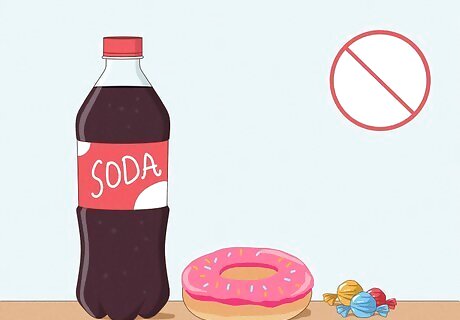
Cut out foods from your diet that have a lot of sugar. High-glycemic (high sugar) foods have been shown to lead to inflammation and the build-up of bacteria associated with acne. Dairy products can also affect some people this way. Changing your diet can lead to a reduction in acne outbreaks. Foods that are low-sugar include vegetables (except beets, pumpkin, and parsnips), fruits (aside from watermelon and dates), rolled oats and bran cereals, whole wheat and whole-grain bread, whole-grain pasta, nuts, legumes, yogurt, brown rice, barley. Consider eliminating sugary soft drinks from your diet and reducing the amount of foods you eat with processed sugar, like candy, donuts, baked goods, and other similar foods.
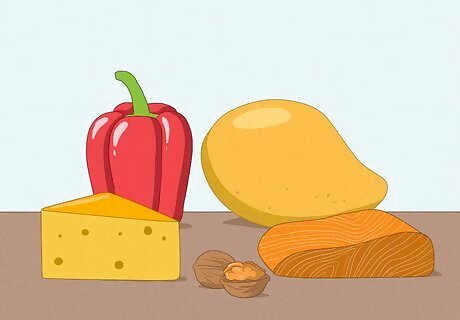
Get more skin-friendly nutrients to avoid breakouts. Vitamins A and D are the most important vitamins for overall skin health. Omega-3 fats are another nutrient that can help reduce acne due to their anti-inflammatory properties. Vitamin A rich foods include spinach, carrots, broccoli, red peppers, sweet potatoes, and summer squash. Fruits that contain vitamin A include mangoes, cantaloupe, and apricots. Legumes are a good source of vitamin A, as well as meat, and fish, such as herring and salmon. The best way to get Vitamin D is to go out into the sun for 10 to 15 minutes in the morning or late afternoon a few times a week. Foods with high levels of vitamin D include fish like salmon and tuna, along with cod liver oil. Vitamin D is also found in dairy, such as milk, yogurt, and cheese. Omega-3 fatty acids are found in nuts and seeds, such as flaxseeds, flaxseed oil, chia seeds, butternuts, and walnuts. Other great sources for omega-3s are salmon, sardines, mackerel, and whitefish. Vegetables like spinach and Chinese broccoli also contain omega-3s.
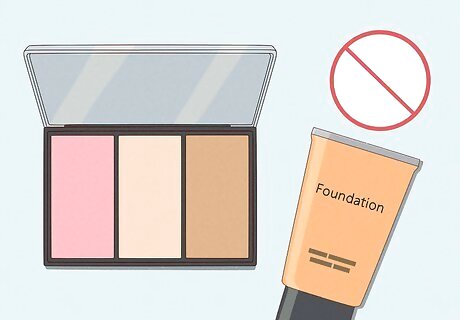
Steer clear of skin irritants. Wearing tight clothes or having makeup on your skin can make hard pimples worse. These irritants can clog pores or cause irritation. If you do use makeup, make sure to remove it before bed.
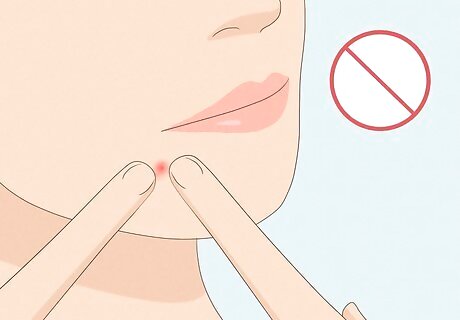
Be gentle with your skin. Roughly touching your skin can cause irritation and make acne worse. Avoid picking at or popping your nodules or cysts, since this can cause flare-ups and lead to longer healing times. The American Academy of Dermatology also recommends avoiding products that irritate the skin. This includes astringents, toners, and exfoliants.
Getting Rid of Hard Pimples with Home Remedies
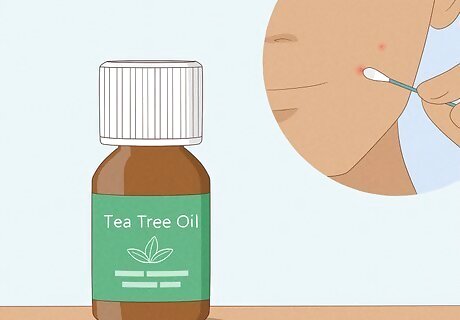
Use tea tree oil. Tea tree oil is one of the most popular ways to remove hard pimples. It has antiseptic, anti-fungal, antibacterial, and anti-inflammatory properties. You can apply tea tree oil directly onto the hard pimples twice a day, or you can dilute it in a non-comedogenic oil, such as mineral oil, argan oil, or olive oil. Put some tea tree oil on a cotton ball or swab and apply it directly to the deep pimple. If you have a sensitivity to tea tree oil, use a carrier oil. Tea tree oil has been shown to be just as helpful as benzoyl peroxide in treating acne. Be careful not to get any tea tree oil near your eyes. Tea tree oil can cause sensitivity and rashes for some people, so always test it first. Put a single drop of the oil on your wrist and wait for 10 to 15 minutes. If there’s no irritation, you should be able to use the oil.
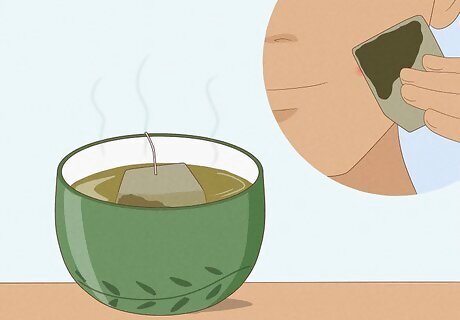
Try green tea. Green tea may have several properties to help treat acne. It is anti-inflammatory and has been shown to possibly reduce oil production. Soak green tea bags in warm water and apply them directly to the hard pimple. The tea will act as an astringent to draw out the pimple and help reduce inflammation. You can also use the brewed tea on your acne. Put some on a cotton ball to spot treat the hard pimple. Since green tea is soothing to your skin, you can apply this treatment as often as you’d like. Start by applying green tea to your acne twice a day.
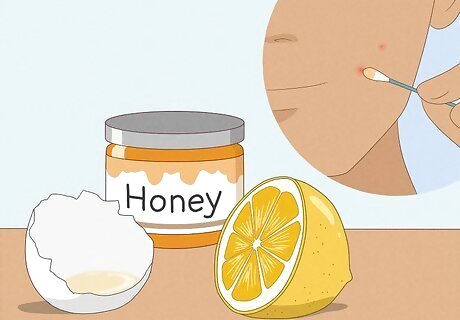
Apply an herbal mask. Herbal masks can help the skin heal while reducing the size of hard pimples. Astringent herbs tighten the skin while the antibacterial herbs help kill off bacteria. This mask can be made with things in your kitchen, and you can add essential oils if you wish. Begin by mixing 1 US tbsp (15 mL) of honey, 1 egg white, and 1 tsp (4.9 mL) of lemon juice. Honey has antibacterial and healing properties. Since lemon juice is a bleaching and whitening agent, you can substitute witch hazel if you don’t want to use lemon juice. Then, add 0.5 US tbsp (7.4 mL) of either peppermint, spearmint, lavender, calendula, or thyme oil. Spread the mixture over your face or wherever else you have acne. If you’d like, use a cotton swab to spread the mixture over specific problem areas. Allow the mixture to dry for 15 minutes. Then rinse it off completely with lukewarm water. Pat the area dry with a clean towel and apply a non-comedogenic moisturizer.
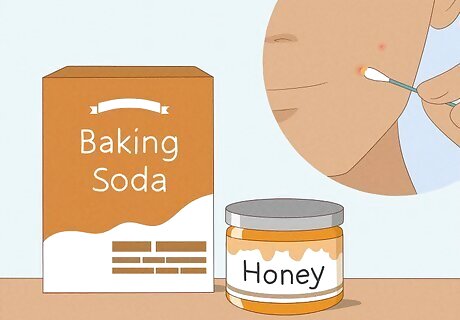
Make a natural exfoliant for your skin. Exfoliation is often not recommended by many skin specialists because skin cells fall off naturally. Rough exfoliation can cause scarring and it can often make acne worse. However, if the hard pimple comes to a head, you can use a very gentle exfoliation technique. Gently exfoliating the skin around hard pimples can help remove any embedded hair, sebum, and cell debris and can accelerate healing. Try the following natural exfoliants that you can make yourself. Make a honey-baking soda exfoliant by mixing 0.25 cups (59 mL) of honey with enough baking soda to make a paste. For an oatmeal exfoliant, grind 0.25 to 0.5 cups (20-40 grams) of rolled whole oats in a food processor or coffee grinder. Add enough olive, jojoba, vitamin E, avocado, or almond oil to make a paste. To make a sugar-olive oil exfoliant, mix a teaspoon of sugar with 0.5 cups (120 mL) of olive oil. You can also use castor, jojoba, vitamin E, avocado, or almond oil. Make a sea salt exfoliant by putting 2 tsp (9.9 mL) of sea salt in enough olive, jojoba, vitamin E, avocado, or almond oil to make a paste. When using a homemade exfoliant, apply it to your face or affected areas in gentle, circular motions. You can also use a cotton swab or cotton ball to apply to smaller areas. Gently work the mixture into the area for 2-3 minutes, and then rinse with warm water.
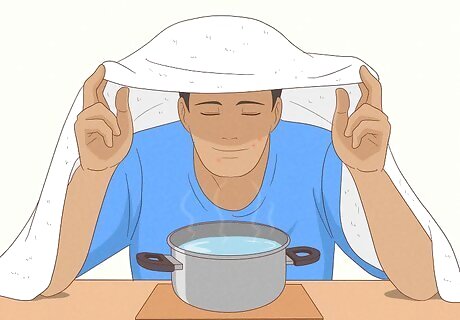
Give yourself a steam treatment. Fill a pot with 1 quart (0.95 L) of water and bring it to a boil. Add a drop or two of an essential oil like spearmint, peppermint, lavender, tea tree oil, or calendula and boil the water for an additional minute. Then, remove the pot from the heat source, place a towel over your head, close your eyes and lean about 1 ft (30 cm) away from the top of the pot. Wash your face before trying this steam treatment, and keep your head over the water for 10 minutes. The steam will open your pores and soothe your skin. Pat your face dry after your done with the treatment. You can then apply a non-comedogenic moisturizer. If your acne is on a location other than your face, you can turn your bathroom into a steam shower by using towels to cover gaps below the door and turning on your shower to the highest heat setting. Remove your clothes and sit on a towel on the floor outside your shower for 15 to 20 minutes. To include essential oils when using your shower as a steam room, boil a bowl of hot water and add a few drops of oils. Then, place the bowl by your shower. If you begin to feel dizzy while in your bathroom, turn off the shower, leave the room immediately, and drink some cold water to keep you from becoming dehydrated.
Getting Rid of Hard Pimples with Medical Treatments
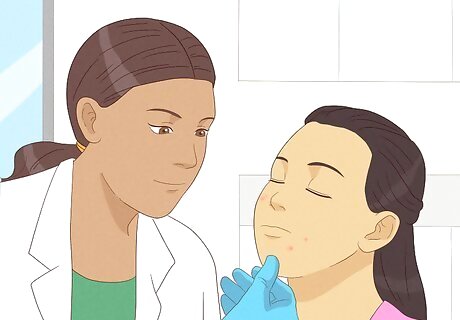
Visit your dermatologist. If you have hard pimples, it’s a good idea to see a dermatologist. They can treat your acne and help prevent scarring. If you have tried any over-the-counter or at-home methods for 2-3 weeks and have seen no improvement, visit your doctor.
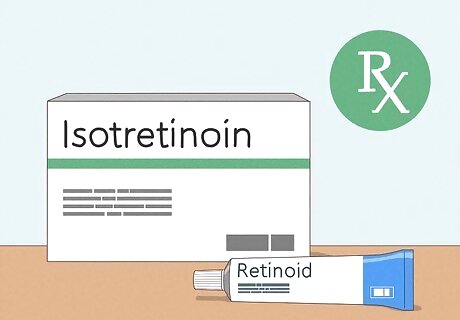
Take medicine prescribed by your doctor. This medicine may be able to be used in conjunction with at-home treatments. See your dermatologist to discuss your specific case of acne, medication options available, and any side effects. Common treatments include retinoids, topical or oral antibiotics, oral contraceptives (for women), an anti-androgen agent, or isotretinoin. If you have an isolated acne lesion, your dermatologist might recommend an intralesional steroid injection. This can be an effective way to get rid of acne quickly.

Try skin therapy if standard solutions aren’t working. If you have tried at-home treatments and medication with no success, your doctor may suggest a different treatment. These include: Lasers and other light therapies: Lasers and light therapies can kill off and reduce bacteria that cause pimples. Chemical peels: These are professional strength chemical peels. Though these are most often used to treat blackreheads and papules, your dermatologist may feel that these can benefit you. Acne removal: This is procedure is called drainage and extraction and is used for larger nodules and cysts. It may be an option when the nodules or cysts do not respond to other treatments.















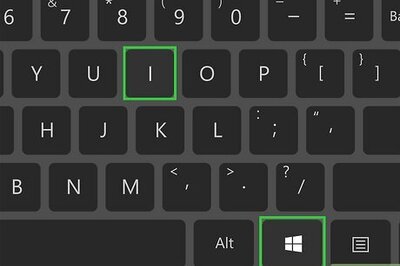

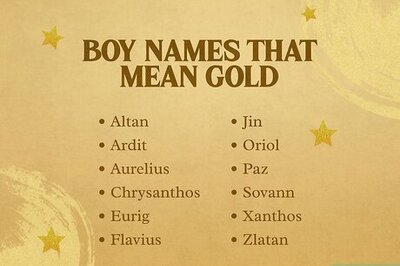

Comments
0 comment